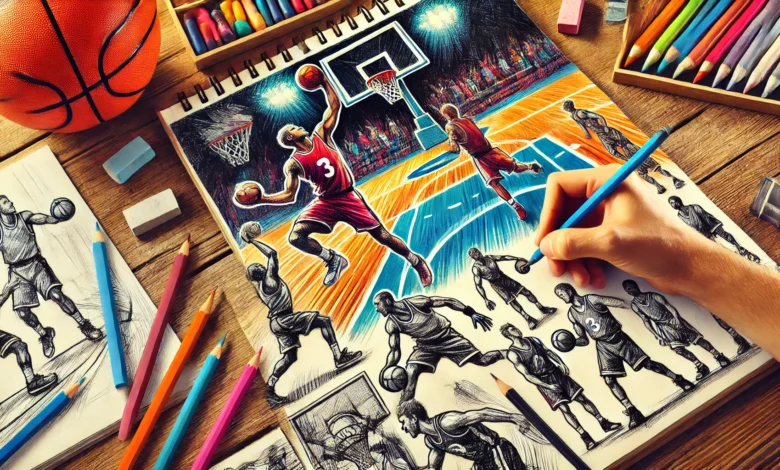Drawing:_tpnhdiv3r8= Basketball: A Complete Guide to Artistic Expression Through Sports

The world of art and sports often intertwines in fascinating ways. Drawing:_tpnhdiv3r8= basketball One of the most interesting overlaps is in the realm of sports illustration, where artists capture the dynamic energy of sports like basketball through their unique skills. Drawing:_tpnhdiv3r8= basketball is one such subject that showcases the power and beauty of the game through artistic expression. In this article, we’ll dive deep into the fascinating process of creating basketball-themed art, its significance, and the many ways artists use drawing to capture the essence of basketball.
What is Drawing:_tpnhdiv3r8= Basketball?

When we talk about drawing:_tpnhdiv3r8= basketball, we are essentially referring to the art of drawing scenes, players, and elements from the basketball world. This form of illustration captures the fast-paced and dynamic movements of the sport, turning them into still images that speak volumes about the game’s energy, strategy, and spirit.
Artists often use different techniques and styles to convey the excitement and precision of basketball, from detailed pencil sketches to digital art forms. Whether it’s a player soaring to make a dunk, a critical game-winning shot, or a moment of intense action, basketball offers plenty of inspiration for artists to work with.
Why Basketball is an Inspiring Subject for Artists
Basketball, with its high-intensity action and emotion, presents many opportunities for artistic exploration. Here are some reasons why basketball makes for such an exciting subject for artists:
- Movement and Motion: Basketball is a sport defined by constant movement—players running, jumping, dribbling, and shooting. Artists capture these dynamic movements, making each drawing feel alive.
- Emotion and Drama: The ups and downs of a basketball game, the intensity of competition, and the passion of the fans create a compelling narrative that artists love to explore.
- Athleticism: The sheer skill and athleticism required to play basketball make it a visually captivating sport. Artists often emphasize the strength, agility, and grace of players in their work.
- Storytelling: Every game has its own story, and artists can depict pivotal moments—like buzzer-beaters or game-winning blocks—that encapsulate the drama of a match.
Techniques Used in Drawing:_tpnhdiv3r8= Basketball
Artists approach the subject of drawing:_tpnhdiv3r8= basketball in various ways, using techniques that bring the sport’s energy to life. Below are some common methods artists employ when illustrating basketball-themed art:
- Pencil Sketching
One of the most traditional ways to draw basketball is through pencil sketches. Artists often start with light pencil lines to outline the basic shapes and then use shading to create depth, form, and movement.
- Benefits: Pencil sketches allow for quick alterations, making them ideal for capturing the fast-paced action of basketball.
- Techniques: Artists use techniques like hatching, cross-hatching, and shading to depict light and shadow in dynamic basketball scenes.
- Digital Art
In today’s digital age, many artists use tools like Adobe Photoshop or Procreate to create basketball artwork. Digital drawing allows for a variety of effects, such as the ability to blend colors smoothly, add textures, and even animate scenes.
- Benefits: Digital platforms offer greater flexibility, allowing for edits and experimentation without the limitations of traditional media.
- Techniques: Artists can employ layering, gradient fills, and special brushes to simulate motion and enhance realism.
- Charcoal Drawings
Charcoal is another medium used to create basketball illustrations, particularly when artists want to evoke intensity and dramatic contrasts. Charcoal’s bold strokes and soft textures add a raw, gritty feel to the artwork, often capturing the physicality of the game.
- Benefits: Charcoal is perfect for creating expressive and bold drawings that emphasize emotion and drama.
- Techniques: Artists use broad strokes to depict the movement of players and fine lines to detail jerseys, basketballs, and other elements.
Understanding the Elements of Basketball Art
To truly appreciate drawing:_tpnhdiv3r8= basketball, it’s important to understand the key elements that artists focus on when illustrating the sport. These include:
- Action Poses: The essence of basketball art lies in capturing action, whether it’s a player mid-dunk, leaping for a rebound, or making a fast break down the court.
- Facial Expressions: The emotion on a player’s face, such as determination, focus, or excitement, can add depth to a drawing.
- Court Details: The court, the basketball hoop, and even the crowd can all play a significant role in the artwork’s composition, setting the scene for the action.
- Jerseys and Branding: The style of uniforms, logos, and colors of the teams help situate the art within a particular game or season.
How Artists Capture the Speed and Energy of Basketball
Basketball is all about speed and fluidity, and capturing this in a drawing requires great skill and attention to detail. Artists employ several techniques to convey the rapid pace of the sport.
- Motion Lines: Motion lines are used to suggest movement and direction. These lines can make a player appear to be running, jumping, or shooting in mid-air.
- Blurring Effects: Some artists use slight blurring to give the illusion of fast motion. For instance, the background might be blurred while the player remains sharply focused.
- Exaggerated Proportions: To emphasize the speed and strength of the players, artists may exaggerate certain features—such as long limbs or powerful muscle tone.
The Role of Color in Basketball Drawings
Color plays a crucial role in any basketball-themed artwork. Whether an artist is working with traditional media like colored pencils or digital tools, color choices can influence the tone and emotion of the piece.
Common Uses of Color:
- Team Colors: Artists use team colors to create a sense of identity and pride. A jersey in bold reds, blues, or greens instantly tells the viewer which team is playing.
- Contrast and Highlighting: Bright colors may be used to highlight important aspects, like the basketball itself or the players’ uniforms. Darker tones may represent the background or areas of shadow.
- Mood: The overall color palette can evoke certain moods—such as a bright, energetic feel for an upbeat game or muted tones for a more somber moment.
Famous Basketball Artists and Their Work
Many well-known artists have focused their attention on basketball, capturing its drama, passion, and energy through their work. Some of the most influential basketball artists include:
- Charly Palmer: Known for his dynamic depictions of African American culture and sports, Palmer has created powerful representations of basketball players.
- Kerry James Marshall: His work often addresses themes of identity, culture, and the experience of African Americans in sports.
- Mark Bradford: Using basketball as a metaphor for community and identity, Bradford’s artwork often includes elements of urban life and popular culture.
Popular Basketball Drawing Styles
There are a variety of drawing styles that artists use to illustrate basketball. These styles range from hyper-realistic to abstract interpretations of the sport. Some popular styles include:
- Realism: Artists create highly detailed and accurate depictions of players, capturing the true likeness of the athletes in action.
- Cartoon Style: In a more playful approach, artists may exaggerate proportions and expressions, adding a fun twist to the game.
- Abstract Art: Some artists use abstract forms to convey the energy and movement of basketball, focusing on shapes and colors rather than realistic depictions.
The Impact of Basketball Art on Fans and Culture
Drawing:_tpnhdiv3r8= Basketball isn’t just about the visual appeal—it plays a significant role in the culture of basketball fans and the broader sports community.
- Inspiration: Basketball art often inspires fans, especially young players who look up to their favorite athletes.
- Cultural Representation: Art can reflect the cultural impact of basketball, especially when depicting important games, legendary players, or iconic moments in basketball history.
- Connection to the Game: Fans and artists often feel a deep connection to the sport, and artwork allows them to celebrate and share their love for basketball creatively.
Conclusion: The Artistic Power of Basketball
In conclusion, drawing:_tpnhdiv3r8= basketball isn’t just about the physical action on the court—it’s a reflection of the sport’s intensity, emotion, and culture. Whether it’s through detailed sketches, vibrant digital paintings, or abstract representations, artists capture the essence of basketball in ways that resonate deeply with fans. Through these drawings, we see more than just athletes in motion—we witness the passion, struggle, and triumph that make basketball one of the most exciting sports in the world.
By continuing to explore and appreciate basketball art, we not only honor the athletes but also the creativity and talent that bring the sport to life on the canvas.
